America’s Cup: Assessing AC75 design
Published on December 6th, 2020
Joop Slooff, author of The Science behind Sailing and Australia II and the America’s Cup; the untold, inside story of The Keel, takes us on a deep dive of the boats to be sailed in the 36th America’s Cup:
A year ago I published an article in Scuttlebutt Sailing News about “The Flying Machines of the Magnificent America’s Cup Men”, referring to the movie Those Magnificent Men in their Flying Machines, all focused on winning the Great Air Race of 1910 from London to Paris.
In the article some design characteristics were discussed of the first boats of the four contenders for the 36th America’s Cup races, to be held in New Zealand in a couple of months from now.
In the past few months and week the three challengers (Luna Rossa Prada Pirelli, New York Yacht Club American Magic and INEOS Team UK) and the Defender Emirates Team New Zealand have launched their second and definitive boats for the Great Race. The current article is meant to consider the differences between the first and the second boats of the contenders and to compare them from an aero-hydrodynamic point of view.
Hulls
As explained in the article a year ago, the hull of an AC75 in foiling mode should have zero lift, zero heel, and (almost) zero distance between the bottom of the hull and the water surface. Obviously, this has been recognized by all the teams. Nevertheless, there are large differences between the hull designs, the bottoms of the hulls in particular.
Among the first generation boats, of about a year ago, Luna Rossa sported a modest, V-type kind of ‘ridge’ at the bottom of the hull that turns gradually into a shallow, long skeg or ‘keel’ all the way up to the rudder. The Kiwi boat Te Aihe had a wider, more voluminous, U-shaped longitudinal bulge, that, however, does not seem to run all the way to the stern. The others had a more or less flat bottom. (See story by Taglang and Chevallier for an excellent overview). INEOS, however, added a thin, shallow skeg to the forward 70% of the bottom of their hull at a later stage.
The new boats now all have some kind of keel ridge or skeg, with a shape that differs from one boat to another.
INEOS Team’s Britannia II exhibits the most conspicuous one, thick, square-cut, and over the full length of the hull, much more pronounced than the in-between modification in the early summer on boat #1. It also has an additional ‘disc’ of volume on the bottom of the rear part of the hull, called the ‘bustle’.
The bottom ridge and skeg on Luna Rossa II, also full length, looks very similar to that on #1. The ridge on American Magic’s Patriot is modest and does not extend over the rear 30% or so of the length of the hull. That on the #2 Kiwi boat Te Rehutai is of a size comparable with Britannia II, but a little more rounded and it does not extend over the rear 20% or so of the length of the hull.
In discussions about the function of the keel ‘ridges’ on the the first series of boats, it has been argued that their main purpose is to promote transition from displacement mode to foiling mode at a low boat speed. However, there are probably two different mechanisms at work for this purpose.
One is a reduction of the wetted area of the flat bottom of the hull at pre-transition boat speeds, when only a portion of the boat’s weight needs to be supported by buoyancy. This may also be the objective of the ‘bustle’ under the British boat. A second function may be to generate some additional, dynamic vertical lift through planing, before all of the hydromechanic lift is produced by the foils.
Luna Rossa’s speed-boat inspired V-section may have been designed specifically for this purpose. An even more pronounced V-section can be seen on the Kiwi defender Te Rehutai.
A third function of the ‘ridges’, their forward parts in particular, is believed to reduce the risk of a pitch-poling type of incident when the boat loses its longitudinal balance.
In the displacement mode the long keel ‘ridges’ will produce some side force due to leeway, plus associated induced resistance. This counteracts any friction drag reducing objective of the ‘ridge’ in the transition mode. Without detailed simulation, it is difficult to tell what the net result is, but it is clear that it is advantageous to let the struts and the rudder generate most of the side force required to balance the side force of the sails.
Because of their relatively deep draft, they will produce only a small amount of induced drag. With most of the side force produced by the struts and rudder, the angle of leeway will be small and the long ‘keels’ will not produce much induced drag either.
Since the appearance of the conspicuous, long, thick keel ridge or skeg of ‘Britannia’, there has been a lot of speculation about its role in the foiling mode, when the name of the game is aero- rather than hydrodynamics.
As mentioned above and explained in the Scuttlebutt article of about a year ago, the aerodynamic efficiency of the rig and sails, plus the hull on which they are mounted, requires that the hull should have zero vertical lift and be as close to the water surface as possible, with zero heel. Here, the ‘long keels’ may have a positive effect in the sense that they reduce the effective width of the gap between the bottom of the hull and the water surface. The ‘long keels’ will form a (partial) obstruction for the cross-wind passing through this gap.
As a result, there will be more cross-wind passing over the top of the hull and a stronger deck-edge vortex. The latter is felt by the lower part of the sails in the sense of an increased apparent wind angle and increased apparent wind speed. Hence, more power from the sail. (The mechanisms involved are described in some more detail in “The Science behind Sailing”.)
There are, however, also negative aspects. The long ‘keel ridge’ or skeg will produce an aerodynamic side force in the foiling mode with associated vortex shedding from the sharp edges at the bottom. The vortex shedding from the skeg means induced drag. There is also additional aerodynamic friction drag due to the increased total air-‘wetted’ surface. The latter is different from the situation in the displacement or transition mode when the flat part of the bottom of the hull is less water-wetted due to the buoyancy of the keel ridge.
Without detailed simulation it is, again, difficult to tell whether the increased power of the sails will dominate over the additional aerodynamic drag of the hull and its keel ridge or the other way around. One thing is clear, however, is the simulations by the British and the Kiwis must have told them that there is something substantial to be gained by the long, thick ‘commonwealth keels’.
Conversely, the simulations by Airbus for American Magic must have produced less optimistic results. The Italians seem to be pretty convinced that they have found a nice compromise, given the fact that, in this respect, there is no apparent big change between their first and their second boat.
An aspect that I have not seen addressed so far in the commentaries is that of directional stability. There is reason to believe that foiling sailing yachts are directionally unstable. This is due to the fact that they miss the stabilizing effect of a submerged hull. The contribution of the aerodynamics of the hull are known to be destabilizing. It means that continuous rudder action is required to keep the boat on course. This causes additional resistance. The long keel ridges/skegs on some of the boats may have an advantage in this respect.
In an attempt to typify the four hulls one might say that the hull of the defender Te Rehutai was designed for sailing while the American boat was designed for flying. (The latter is perhaps not surprising, given the fact that Airbus participated in the design). Luna Rossa looks like a design with a sensible compromise between sailing and flying. The British boat looks like a radical departure from common knowledge.
Foils
There are also obvious differences between the foils of the boats, both between the different contenders as well as between the first and second series of boat of the same contender. The most striking changes are Luna Rossa and the Kiwis.
The first Luna Rossa had W-shaped wings and a substantial bulb at the intersection with the strut, with no longitudinal off-set between the wings and the strut. The new boat has no bulb at the intersection but a significant amount of longitudinal off-set and a proper leading edge fillet where the strut meets the wings. These properties avoid or reduce adverse hydrodynamic interference between the wings and the struts.
Another attractive aspect is that the inner edge of the trailing edge flap move up and down closely against a flat part of the tip of the strut. This implies no edge vortex at the inner tip of the flap and improved flap efficiency. A final attractive aspect is formed by the winglets at the tips of the foils wich also improve the hydrodynamic efficiency.
There is also one questionable aspect. With the foil mounted a little forward of the strut and attached in the rear there is some risk of structural dynamic problems like flutter (potentially catastrophic) or limit-cycle oscillations (potential fatigue problems). However, we may hope that the team has addressed this risk by designing for sufficient stiffness of the construction.
The foils of the second Kiwi boat Te Rehutai are also significantly different from those of its predecessor Te Aihe. The wings, with no, or very small, anhedral and maximum span, look similar to those of Te Aihe. However, there is a large difference in the way the wings are mounted on the struts.
In the case of Te Aihe, there was no apparent bulb at the intersection and no longitudinal off-set of importance. In the case of Te Rehutai, there is a considerable amount of longitudinal off-set with the wings substantially further rearward than the strut. This should mean less adverse hydrodynamic interference between the strut and the wings. An additional favorable aspect is that, in combination with the small or zero anhedral, the trailing edge flap can run along the full span of the wings, without interruption. This implies maximum flap efficiency.
Because the front part the foil wing is attached to the strut there is hardly any risk of structural dynamic problems.
Another point worth mentioning is the relatively short chord of the strut in its submerged part and at the intersection. This reduces the friction drag penalty associated with the zero anhedral of the wings. The function of the thinkened, cuff-like part of the foils is unclear at this stage. It could be that covers an attachment system that allows easy replacement of the foils.
There are also significant differences between the foils of Britannia I and II. While the first boat had a substantial bulb at, and forward of the intersection between the foils and the struts, the second boat has only a small, short body at the intersection, ending in a small horizontal ‘beaver tail’ just aft of the trailing edge. The latter is probably better than a bulb with a pointed rear end.
The root chord of the foils is about the same as the bottom chord of the strut and there is no apparent longitudinal off-set between the two. This probably means some adverse hydrodynamic interference between strut and foils.
There is also a difference in anhedral. The foils on boat #1 had, in front view, a simple one-piece negative slope. On boat #2 there is a kink in the front view; only the inner half of the foils have anhedral, the outer halves are more or less horizontal. On the average, the foils may, in this way, be a little further from the water surface, with a reduced risk of cavitation/ventilation.
However, a potential disadvantage of this configuration could be that the trailing edge flaps have to be segmented, with, possibly, a small gap between the two segments when the flap is deflected. When this gap is not sealed by some flexible material it will reduce the efficiency of the flaps. This holds also for inner edges of the flaps where they meet the small central body.
The available material shows, like the other foils, small winglets at the tips (although this is not evident from the pictures).
The apparent differences between the foils of the American boats Defiant and Patriot are small. The main difference seems to be a slightly more rearward and fatter bulb for Patriot. Unfortunately, the bulb does not have a fish tail or a beaver tail. It is also a disadvantage that the flaps do not seem to run inboard all the way up to the bulb. This means a reduced efficiency of the flaps.
Comparing the four designs from a hydrodynamic point of view their common, most important characteristic is that they all utilize the maximum allowable span. This means a low induced resistance due to lift.
With respect to adverse hydrodynamic interference between the foils and the strut it would seem that the Kiwi boat Te Rehutai and Luna Rossa II have the best papers. Te Rehutai is probably also the least vulnerable for cavitation and ventilation phenomena because of the the relatively large distance between the foils and the water surface.
All boats appear to kick up a lot of spray from the struts in the foiling mode. Because spray implies additional drag this is not a good thing. None of the design teams have apparently succeeded in reducing spray significantly (if they have attempted to do so).
A final remark on foils is that none of the boats seem to make use of super-cavitating foil sections. The reason is probably that these give too much drag at sub-cavitating boat speeds.
Rudders
In the absence of detailed pictures of the rudders, little can be said about the rudder foils. All the teams seem to have gone for the maximum draft of the vertical part of the rudder which leads automatically to a horizontal tail foil. It is not obvious that any of the teams has found a convincing solution to the problem of minimizing the interference between the vertical rudder blade and the horizontal foils.
Sails
There have hardly been any comments in the media about the sails. This is understandable because the rules do not leave (much) room for variation. Besides it is impossible to see any details in the possibilities for the trimming of, e.g., the camber of the sails. The latter is important because the displacement and transition modes will require appreciably more camber than the foiling mode.
A point to be mentioned is that now all contenders seem to have closed the gap between the boom of the mainsail and the deck (see pictures below for Defiant and Patriot). This is important for the aerodynamic efficiency of the sails. The latter applies of course also to the foresail.
“And the winner is…..”
Having considered and compared the main characteristics of the four contenders for the 36th America’s Cup in some detail, it is, of course, tempting to indicate who is the best. Unfortunately, it is impossible to do so without full simulation of the boats as a whole.
Besides it is, fortunately, impossible to simulate the actions of the crew and the environmental conditions (wind and waves) that will occur during the races. There is no doubt, however, that the best combination of crew and boat for the reigning conditions will win….


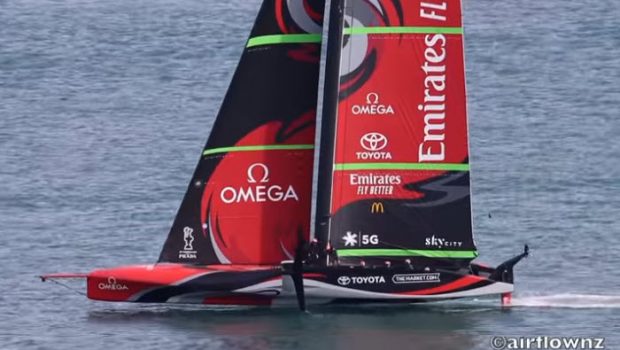

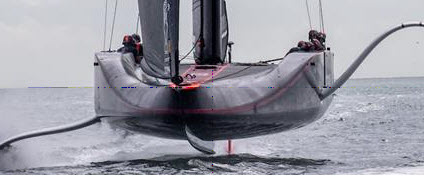

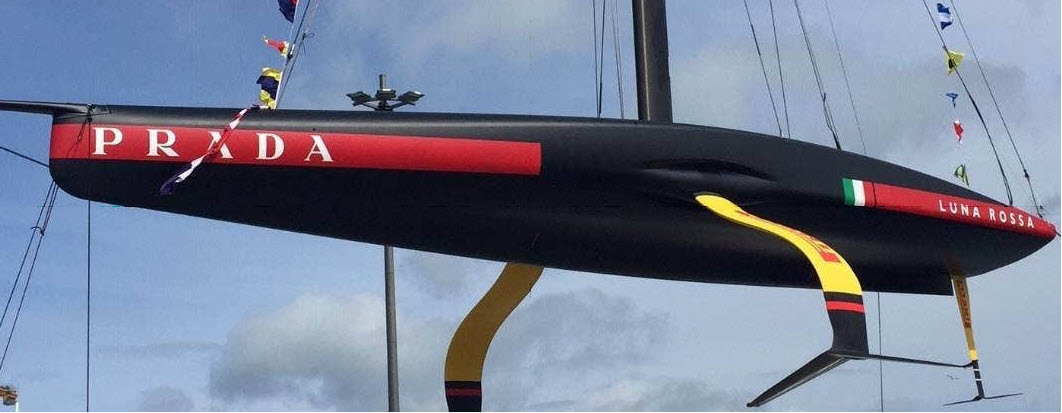
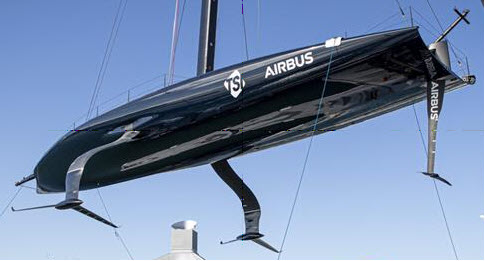
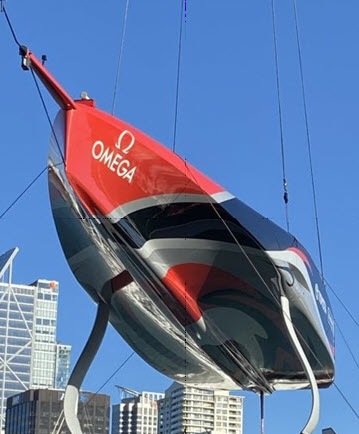
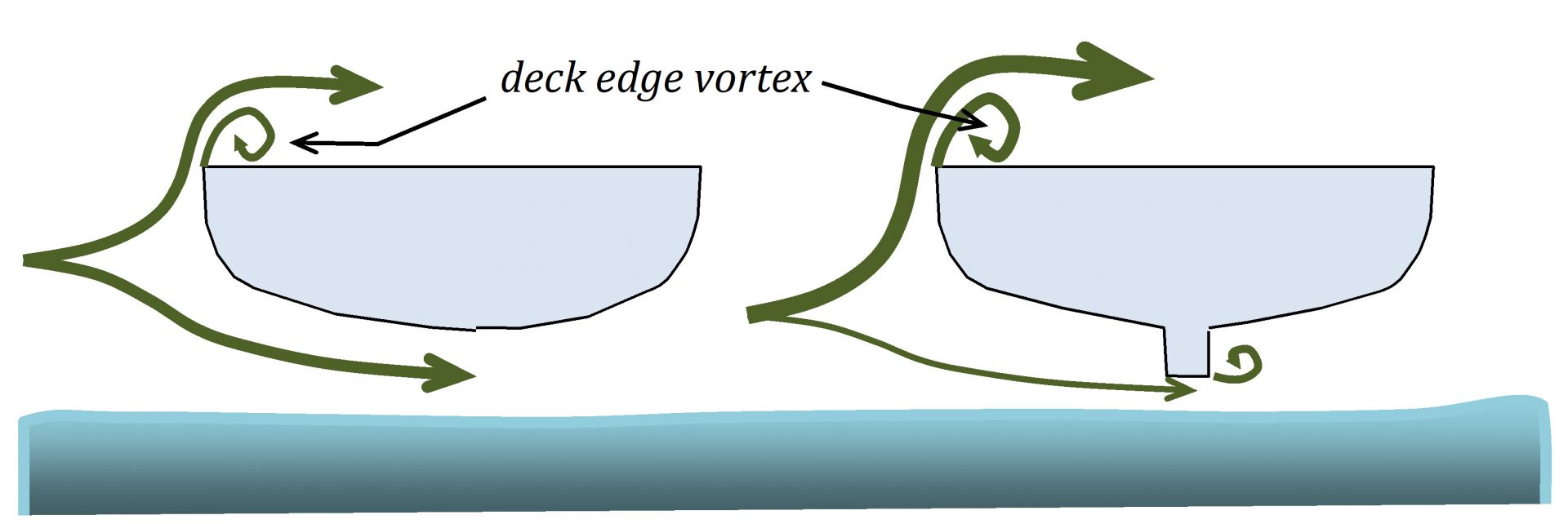
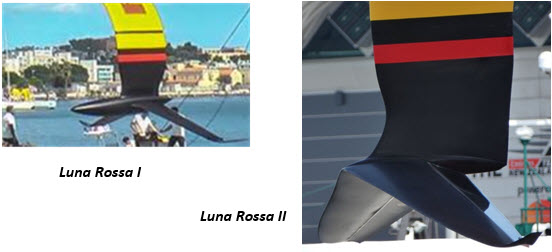
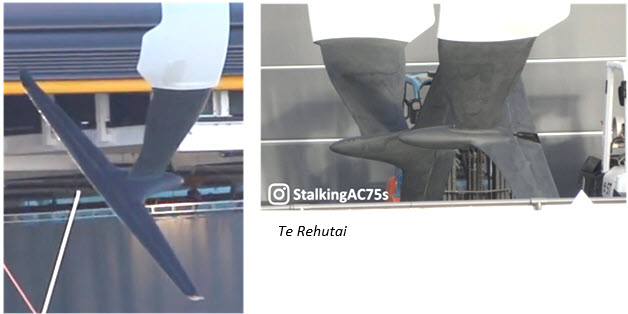
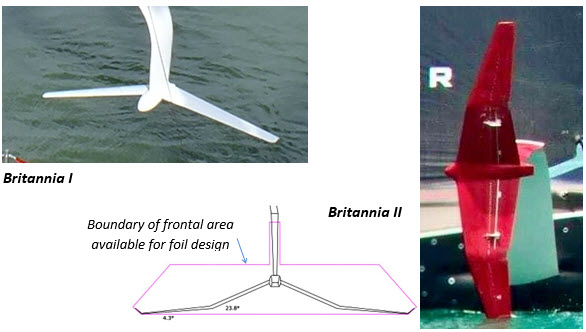
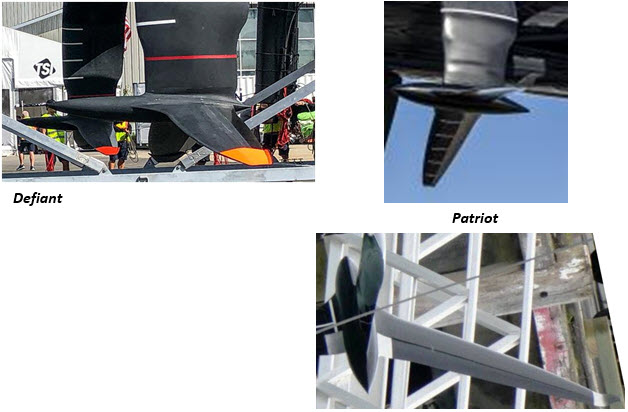



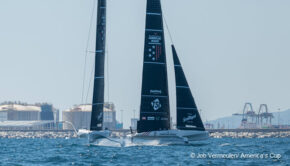
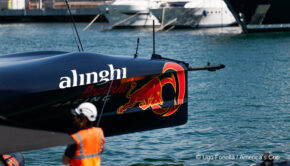

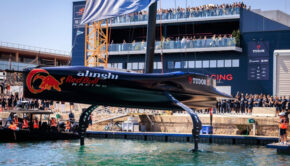
 We’ll keep your information safe.
We’ll keep your information safe.